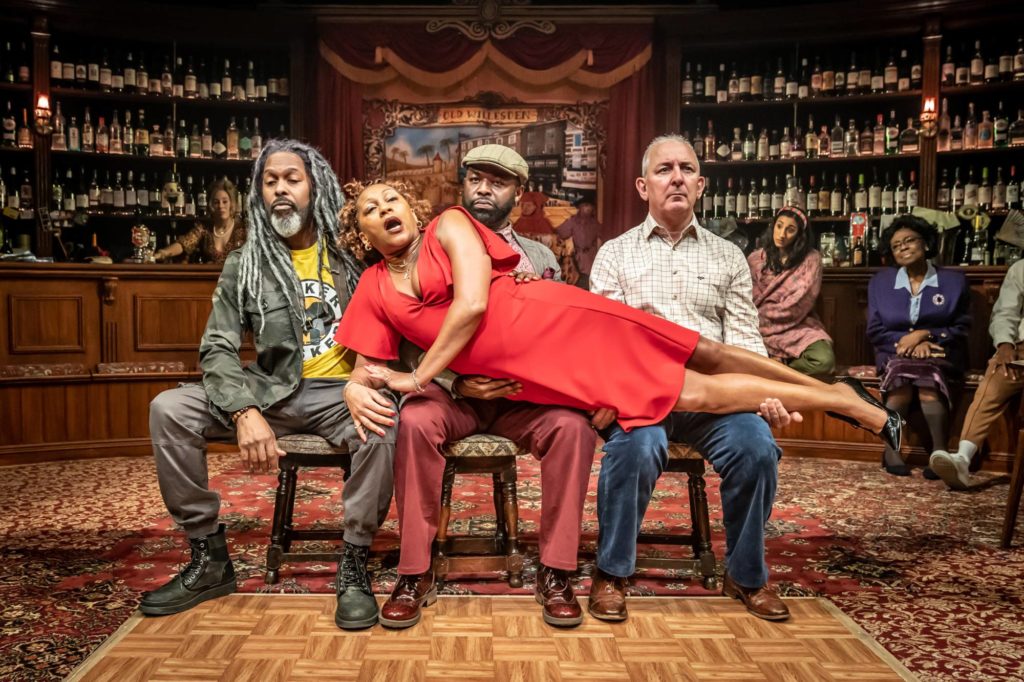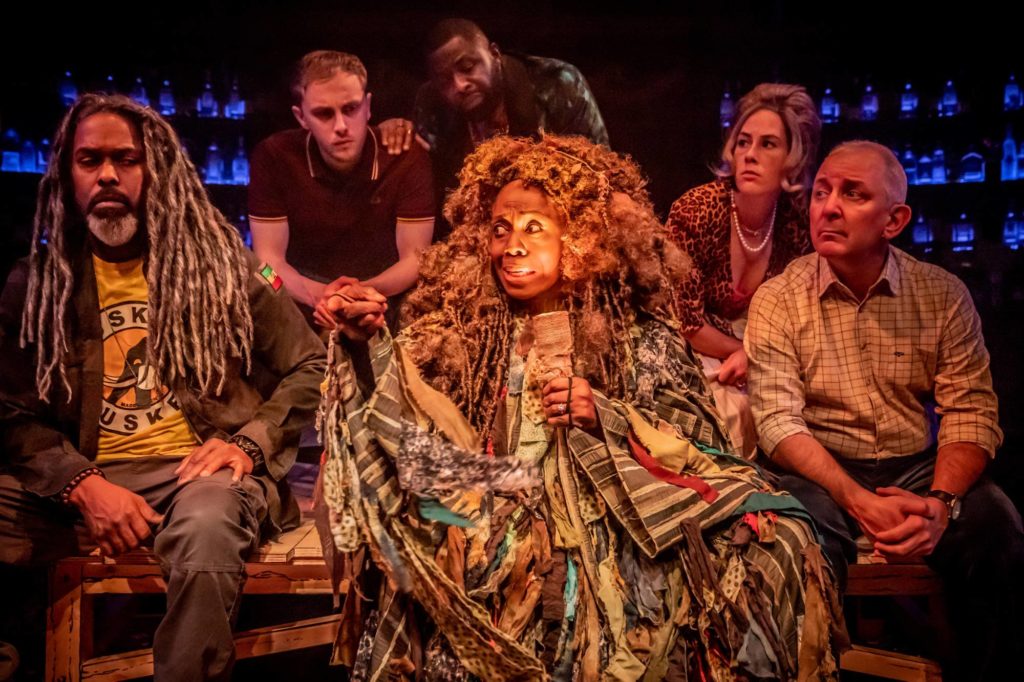
Marcus Adolphy, Clare Perkins, George Eggay, Andrew Frame, and the company of “The Wife of Willesden.” Photo: Marc Brenner
A Kiln Theatre Production presented by the American Repertory Theater
Adapted by Zadie Smith, adapted from Chaucer’s “The Wife of Bath”
Direction by Indhu Rubasingham
Composition and sound design by Ben and Max Ringham
Movement Direction by Imogen Knight
Fight Direction by Kev McCurdy
Voice & Dialect Coaching by Hazel Holder
February 25 – March 17
Loeb Drama Center
64 Brattle Street
Cambridge, MA 02138
Tickets and Info
Critique by Maegan Bergeron-Clearwood
Cambridge, MA –Loud, rebellious female characters from classic literature are juicy fodder for feminist reclamation, and understandably so. For women and folks of marginalized gender identities, it’s rare to see ourselves reflected as complex human beings in historical texts, even if most of these surviving texts are by dead white men. Shakespeare, for instance, likely didn’t have radical feminist intentions when he wrote Taming of the Shrew. But, Kate’s story is reshaped and retold again and again and again, problematic parts and all, if only to prove to the world that yes, women like her always existed.
The Wife of Willesden, a Kiln Theatre Production currently running at the A.R.T., strives to continue in this tradition, reexamining with the titular character from Chaucer’s “The Wife of Bath” (a tale from The Canterbury Tales) through a 21st century lens. The text was adapted (or translated, which I would argue is more accurate) by novelist Zadie Smith, with raucous, ensemble-driven direction by Indhu Rubasingham.
The Wife of Bath’s tale as written by Chaucer is essentially one extensive monologue in two parts: a prologue that’s longer than the tale itself, in which the titular character narrates to her audience of fellow pilgrims the story of her five marriages; and the tale, an Arthurian fable about a man who is forced to do penance for raping a woman. In The Wife of Willesden, the Wife (played by Anne Perkins) tells her stories to a crowd of locals in a West London pub, with ensemble members playing various characters to bring the narration to life.
I have many conflicting thoughts about the feminist stance of this production, but first, a more straightforward observation: the production elements and performances are simply stunning. The scenic design by Robert Jones is particularly masterful; despite the size of the A.R.T.’s space, Jones manages to make the pub feel inviting and lived-in, seating some audience members onstage to make the performance feel more intimate.
All of the performers are brilliant storytellers, with impeccable command of Smith’s verse; London is a beautifully diverse city, so it’s especially refreshing to see this reflected in the also-diverse ensemble. As for the Wife herself – a 50-something woman who knows what she wants (usually sex) and how to get it – Perkins imbues her with “yass queen” diva energy, delivering what is essentially a 95-minute monologue with seemingly limitless stamina (and in heels!).

Marcus Adolphy, Scott Miller, George Eggay, Ellen Thomas, Claudia Grant, and Andrew Frame. Photo: Marc Brenner
But Smith’s script is a conundrum. In terms of craft, her translation of Chaucer’s original Middle English text is gorgeous: the language flows seamlessly from one rhyming couplet to the next, with such a conversational, even tone that I often forgot I was listening to verse. In terms of dramaturgy, however, Smith delivers an almost one-to-one translation of the source material; with the exception of some reordering and cuts, and the inclusion of modern slang, the text is a remarkably literal rework of Chaucer’s.
The result is not so much a feminist adaptation so much as a stylistic update: a Middle English play superimposed onto a 2023 pub setting. This is a common staging practice, as seen with Shakesperean plays being told in the context of more contemporary times or circumstances, the juxtaposition prompting the audience to question how issues of centuries ago still do (or don’t) resonate.
But Smith modernizes the script of The Wife of Willesden just enough that the text/setting juxtaposition muddles its politics rather than interrogates them. The Wife uses terms like “basic” and “on point,” but the overall narrative stays true to the source material’s 14th century gender norms: marriage is transactionary and exclusively between biologically and socially distinct men and women, and women should be virginal and subservient; within this context, Chaucer’s sexually empowered “Wife of Bath” is subversive and countercultural. The Wife of Willesden, on the other hand, just comes across as girl-bossy.
The issues raised in Chaucer’s text are not irrelevant in 2023: purity culture exists, incels have taken over the Internet, violence against women remains an epidemic (the play dramatizes these issues, but there’s too much slapstick comedy for them to be taken seriously). But The Wife of Willesden is so one-note in its feminism, so generalizing in its depiction of femininity, womanhood, and gender as a whole, that it already feels dated, even though it premiered just last year. Queer feminism (and queer people period) does not seem to exist in this world; when a transphobic visual gag appeared around the halfway point, I was disappointed but not surprised.
“It’s always shocking when women say what is usually said by men,” the Author (the play’s narrator, played by Jessica Murrain) says to the audience. And indeed, with this production, I got to hear an incredibly skillful woman – and an incredibly skillful diverse cast — deliver classical verse, a genre of performance historically delivered by white men.
This element of the production alone is feminist, and if you’re not looking for something deeper, or you if can see past politically stale content for the sake of beautiful production work, that is valid, and you should buy a ticket. But for me, a millennial, a queer feminist, and a lover of politically challenging adaptations of classic literature, I was left itching for something so much more.
